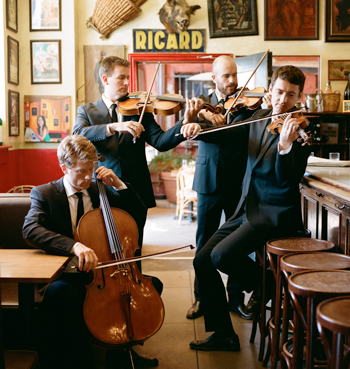by Jarrett Hoffman

Ben Johnston might be a bit more obscure than Cyrus, but you could make a case for the juxtaposition with his String Quartet No. 4 (“Amazing Grace”) that opened the program. The single-movement work is inspired by the popular hymn of the same name, granting it an accessibility that belies its extreme difficulty and complexity.
The Calder made the simple opening pure and pearly. Gradually things shifted toward the wild, with fiddle-like ornaments and pizzicatos made to feel spontaneous by the quartet. Heavenly light seemed to fade as dark minor sonorities colored the melody.
Things got weirder. In one section, nontraditional tuning intervals helped capture a long-forgotten, desolate land — if tumbleweeds had blown through Transformer Station, you wouldn’t have blinked. In another, each member plays a different, complex rhythm, all of which swarmed together like bees. The piece is only 10 minutes long, but when “Amazing Grace” returned at the end, it felt like seeing home again after an epic journey. Any quartet with guts needs to tackle this rarely-performed work.
Hungarian composer Péter Eötvös’s Korrespondenz followed, sporting its own unique language from the start. The opening was full of slides, speeding up to sudden halts — the workings of a tense mind. A cell phone that went off in the audience somehow felt right at home with the chaotic sounds. Slides can sometimes become repetitive, but each one in this performance felt uniquely paced. Some were fast — foot hard on the pedal. Some were slow, like the gradual rise of a thermometer under a fevered tongue. Others were in between.
The language expanded as the piece went on. The Calder made the muted long tones almost chilling in their expanse after the tiki-taka opening. Creaking grinds joined in as well, bows working on strings like rusty gears.
Miley’s images felt most out of place — perhaps charmingly so — in Bartók’s String Quartet No. 6 (1939). Composed with WWII looming, the piece is very, very dark — one section sounds like prisoners in the cold, another like a Nazi march. Jonathan Moerschel’s opening viola solo was hugely expressive, readying your bones for what was to come.
And what followed was really something. In the first movement’s faster sections, the group was so locked in that their trading of material sounded less like conversation than a single brain’s neurons firing into one another, thoughts sparking thoughts. After the Calder’s powerful but heavy take on the second movement, where every phrase seemed to mean life or death, the third movement shrieked and danced like a mad troupe. Maybe Miley was at home after all? The Calder’s final chord still seems to ring, like a time capsule: humming, glistening, knowing.
Published on ClevelandClassical.com November 25, 2014.
Click here for a printable copy of this article



